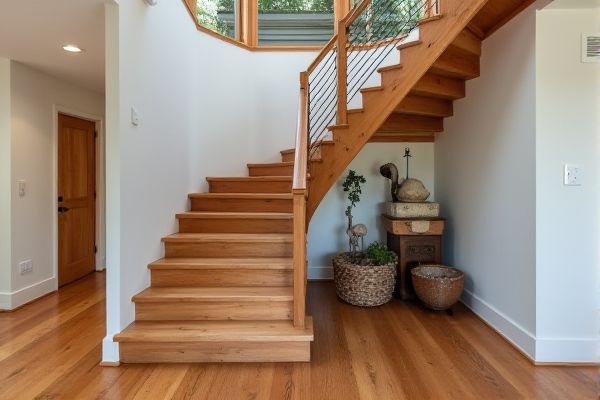
Reclaimed wood stairs offer unique character and environmental benefits by repurposing materials, while new wood stairs provide uniformity, easier customization, and a consistent finish. Explore this article to understand the advantages and drawbacks of each option to help you decide which stair type best suits Your home and style.
Table of Comparison
| Feature | Reclaimed Wood Stairs | New Wood Stairs |
|---|---|---|
| Material Source | Salvaged old wood, environmentally sustainable | Freshly milled timber, sourced from forestry |
| Cost | Generally lower due to reuse, but may vary depending on processing | Typically higher due to new material and manufacturing |
| Durability | Proven long-lasting, often denser and stronger | Good, varies by wood species and treatment |
| Appearance | Unique character with weathered, rustic patina | Uniform, fresh wood look |
| Environmental Impact | Lower carbon footprint, reduces deforestation | Higher environmental impact due to harvesting and processing |
| Installation | May require additional prep for nails, old paint | Simpler prep and fitting |
| Maintenance | May need sealing and care to preserve aged look | Standard maintenance, easier to refinish |
Introduction to Reclaimed vs New Wood Stairs
Reclaimed wood stairs offer unique character, rich history, and environmental benefits through sustainable reuse of aged timber, often featuring distinctive textures and patinas unavailable in new wood. New wood stairs provide consistent quality, uniformity, and customized options, typically resulting in a cleaner, modern aesthetic ideal for contemporary homes. Your choice between reclaimed and new wood stairs impacts durability, style, and ecological footprint, making it essential to weigh the authenticity of reclaimed wood against the predictability of new materials.
Aesthetic Differences: Character and Appearance
Reclaimed wood stairs showcase unique character through weathered textures, natural imperfections, and rich patinas that new wood cannot replicate, offering a rustic and vintage charm. New wood stairs provide a cleaner, more uniform appearance with smoother finishes and consistent grain patterns, ideal for modern and sleek interior designs. Your choice between reclaimed and new wood stairs ultimately influences the aesthetic atmosphere, whether you prefer timeless authenticity or contemporary elegance.
Durability and Longevity Comparison
Reclaimed wood stairs often offer superior durability due to their dense, aged timber that has already withstood years of environmental stress, making them highly resilient and long-lasting. New wood stairs, while visually fresh and uniform, may require more maintenance and treatment to achieve similar longevity, especially if using softer wood species. Choosing reclaimed wood for your stairs not only enhances durability but also adds unique character and sustainability to your space.
Environmental Impact and Sustainability
Reclaimed wood stairs significantly reduce environmental impact by repurposing existing materials, minimizing deforestation, and lowering carbon emissions associated with harvesting and processing new timber. New wood stairs contribute to increased demand for logging, resulting in habitat loss and higher energy consumption during manufacturing. Choosing reclaimed wood supports sustainable building practices by conserving natural resources and promoting waste reduction in construction projects.
Cost Analysis: Upfront and Long-term
Reclaimed wood stairs typically offer lower upfront costs due to the reuse of existing materials, though labor expenses may increase with the need for cleaning and refinishing. New wood stairs generally have higher initial costs because of raw material purchase, but require less maintenance and refinishing, resulting in potentially lower long-term expenses. Over time, reclaimed wood can provide significant savings if properly maintained, while new wood offers consistent durability and fewer unexpected repair costs.
Installation Process and Challenges
Reclaimed wood stairs require careful preparation during installation due to variations in wood quality, moisture content, and potential hidden nails or imperfections, which can increase labor time and the need for specialized tools. New wood stairs offer a more predictable installation process with standardized dimensions and consistent material quality, reducing the likelihood of unexpected adjustments. Both types demand precise measuring and cutting, but reclaimed wood often necessitates additional sanding, filling, and finishing to ensure structural integrity and aesthetic appeal.
Maintenance and Care Requirements
Reclaimed wood stairs often require more frequent maintenance due to their aged texture, potential imperfections, and existing wear that can affect durability. New wood stairs typically need less immediate attention but still benefit from regular cleaning, sealing, and occasional refinishing to preserve their appearance and structural integrity. You should consider the long-term upkeep demands of each option to ensure lasting beauty and safety in your home.
Customization and Design Flexibility
Reclaimed wood stairs offer unique customization options due to their weathered texture, diverse grain patterns, and rich patina, providing a one-of-a-kind aesthetic that enhances rustic or vintage-inspired designs. New wood stairs provide greater design flexibility through uniformity in size, shape, and color, allowing precise cuts and finishes tailored to modern architectural styles. Both materials accommodate intricate detailing and personalized configurations, but reclaimed wood excels in delivering character and historical value.
Common Applications and Best Uses
Reclaimed wood stairs are ideal for rustic, vintage, or eco-friendly interiors where character and sustainability are prioritized, often found in historic renovations or custom homes seeking unique textures and aged patinas. New wood stairs provide uniformity, consistency, and a wide range of design flexibility, making them best suited for modern builds, commercial properties, or spaces requiring precise finishes and durability. Your choice depends on whether you value environmental impact and distinct aesthetics or prefer predictable quality and broad customization options.
Conclusion: Choosing the Right Wood Stairs
Reclaimed wood stairs offer unique character, sustainability, and durability from aged hardwood, making them an eco-friendly choice for rustic or vintage designs. New wood stairs provide consistent quality, customization options, and modern durability suited for contemporary or specific architectural styles. Selecting between reclaimed and new wood stairs depends on balancing environmental impact, aesthetic preferences, budget, and long-term maintenance requirements.
 homyna.com
homyna.com